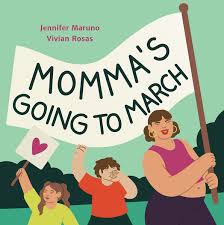Momma’s Going to March

Momma’s Going to March
We cut a big piece of cardboard and mixed some paint.
“Will there be bands and bugles?” I asked. “No,” Momma said.
“It’s not that kind of march.”
We made a sign because Momma’s going to march.
For activist parents, it is never too soon to introduce children to the idea of standing up for social justice. In Momma’s Going to March, mothers of varying ethnicities and their offspring of all ages are shown taking part in public displays for causes such as climate action and peace. Although both the author and illustrator are Canadian, there is a definite American slant to the book as we see families marching for the ERA (Equal Rights Amendment), school integration and voters’ rights, none of which have been major issues in Canada.
A warm feeling of inclusion is evoked by the simple, repetitive narrative as women introduce their children to problems more global than schoolyard spats and lunch preferences. The tone is one of buoyant optimism. The main impetus is obviously to let young people know that they should make their voices heard. Even a small protest might make a difference.
I cut the cloth and painted the letters.
“Will people come?” Momma asked.
“Yes,” I said, sliding in the poles. I made a banner because…
I am marching for the ENVIRONMENT.
My friends gathered behind our message.
I lifted one end. And Momma lifted the other.
Rosas’ digitally-produced images are rendered in muted tones and show solid, two-dimensional figures in a variety of active poses placed on flat backgrounds. Placards are raised; fists are raised in solidarity. There are some interesting points of perspective, like the page that has zeroed in on one hand holding a pair of scissors and another wielding a paintbrush above two large lettered cards. Some of the pictures could themselves be artwork for a poster championing one of these causes.
Pages of back matter discuss items that might be on display at a protest march: clothing of a particular colour, and flags and banners bearing symbols and slogans. The author also speaks of her inspiration for writing the book and briefly outlines the history of a number of notable historical public protests, such as the March on Washington for Jobs and Freedom in 1963 and the 2017 Great Lakes Water Walk.
Maruno has written a very personal book that will most likely be chosen by an adult to share with an individual child. It will then be possible through one-to-one discussion to flesh out some of the historical context and answer questions that will undoubtedly arise. The partisan nature of the subject might prove challenging – and challenged – if introduced in a school setting.
Ellen Heaney is a retired children’s librarian living in Coquitlam, British Columbia.
